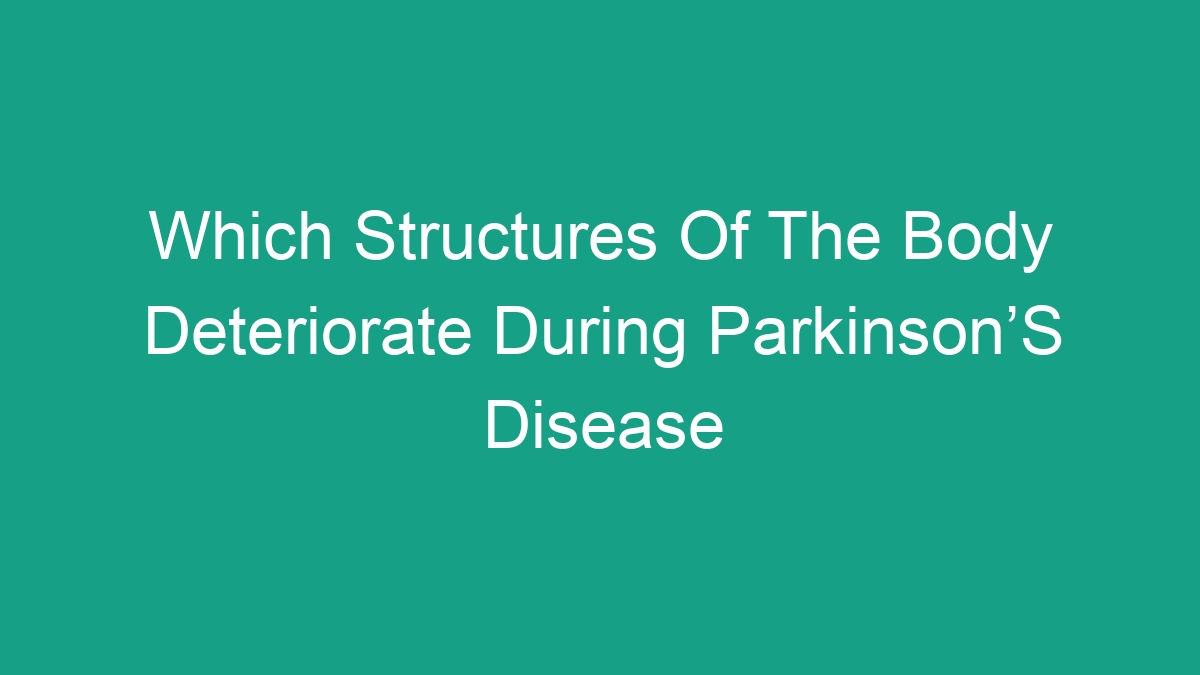
Parkinson’s disease is a progressive neurological disorder that affects movement. It is characterized by a loss of dopamine-producing neurons in the brain, leading to a range of motor and non-motor symptoms. As the disease progresses, various structures of the body deteriorate, resulting in significant impairments in movement and overall functioning. In this article, we will explore the specific structures of the body that deteriorate during Parkinson’s disease and the impact it has on an individual’s health and well-being.
The Brain
Parkinson’s disease primarily affects the substantia nigra, a region of the brain responsible for producing dopamine. Dopamine is a neurotransmitter that plays a key role in regulating movement, emotional responses, and other functions. As the disease advances, the loss of dopamine-producing neurons in the substantia nigra leads to a significant decline in dopamine levels, resulting in motor symptoms such as tremors, rigidity, bradykinesia (slowness of movement), and postural instability.
In addition to the substantia nigra, Parkinson’s disease can also impact other areas of the brain, including the basal ganglia, which is involved in controlling voluntary motor movements, and the cerebral cortex, which is responsible for higher cognitive functions such as decision-making and speech. The deterioration of these brain structures can contribute to a range of motor and non-motor symptoms, impacting an individual’s ability to perform daily activities and affecting their overall quality of life.
The Nervous System
As Parkinson’s disease progresses, it can also affect the peripheral nervous system. This includes the nerves that extend from the brain and spinal cord to the rest of the body, as well as the autonomic nervous system, which regulates involuntary functions such as heart rate, blood pressure, digestion, and bladder control.
The deterioration of the peripheral nervous system can lead to a variety of symptoms, including sensory changes, muscle weakness, and a loss of coordination. Individuals with Parkinson’s disease may experience difficulty with balance and gait, increasing their risk of falls and injuries. Additionally, dysfunction of the autonomic nervous system can result in symptoms such as orthostatic hypotension (a sudden drop in blood pressure upon standing), constipation, and urinary problems, further impacting their quality of life.
The Musculoskeletal System
Individuals with Parkinson’s disease often experience musculoskeletal changes that can affect their mobility and posture. Muscle rigidity and stiffness are common symptoms of the disease, leading to decreased flexibility and range of motion. This can result in difficulties with initiating and controlling movement, as well as an increased risk of muscle pain and cramping.
As the disease progresses, individuals may also develop postural abnormalities, such as stooped posture or a forward-leaning stance, as well as difficulties with balance and coordination. These musculoskeletal changes can significantly impact an individual’s ability to carry out activities of daily living, leading to a loss of independence and functional decline.
The Gastrointestinal System
Parkinson’s disease can also have a significant impact on the gastrointestinal system. Individuals with the disease may experience digestive problems, including difficulty swallowing (dysphagia), which can increase the risk of aspiration and choking. Constipation is also a common issue, resulting from decreased gastrointestinal motility and slowed transit of food through the digestive tract.
These gastrointestinal symptoms can lead to nutritional deficiencies, dehydration, and discomfort, further compromising an individual’s health and well-being. It is important for individuals with Parkinson’s disease to receive proper nutrition and hydration, as well as appropriate medical management for their digestive issues to maintain their overall health.
The Respiratory System
Individuals with Parkinson’s disease may experience changes in their respiratory function as the disease progresses. Muscular rigidity and weakness can affect the muscles involved in breathing, leading to a decreased ability to expand the lungs and effectively exchange oxygen and carbon dioxide. This may result in a reduced exercise tolerance, increased fatigue, and respiratory complications.
In some cases, individuals with Parkinson’s disease may also develop respiratory muscle weakness, leading to compromised respiratory function and an increased risk of respiratory infections. It is important for individuals with the disease to engage in regular physical activity to maintain respiratory function and to seek medical management for any respiratory issues that arise.
The Cardiovascular System
Cardiovascular changes can also occur in individuals with Parkinson’s disease, impacting their heart function and circulation. Orthostatic hypotension, a common autonomic symptom of the disease, can lead to a sudden drop in blood pressure upon standing, causing dizziness, lightheadedness, and an increased risk of falls. Individuals may also experience changes in heart rate variability and increased susceptibility to arrhythmias.
Addressing cardiovascular issues is an important aspect of managing Parkinson’s disease, as maintaining cardiovascular health is essential for overall well-being and quality of life. Managing blood pressure and heart rate, engaging in regular physical activity, and seeking appropriate medical care for cardiovascular symptoms is crucial for individuals with the disease.
Conclusion
Parkinson’s disease is a complex neurodegenerative disorder that can impact various structures of the body, leading to a range of motor and non-motor symptoms. As the disease progresses, the deterioration of the brain, nervous system, musculoskeletal system, gastrointestinal system, respiratory system, and cardiovascular system can significantly impact an individual’s health and well-being, affecting their mobility, independence, and overall quality of life.
It is important for individuals with Parkinson’s disease to receive comprehensive care from a multidisciplinary team, including neurologists, physical and occupational therapists, speech-language pathologists, and other healthcare professionals. By addressing the specific structures of the body that deteriorate during Parkinson’s disease and providing targeted interventions, individuals can better manage their symptoms and maintain their overall health and functioning.
Continued research and advances in treatment approaches are essential for improving the lives of individuals affected by Parkinson’s disease, with the ultimate goal of finding a cure for this challenging condition.



